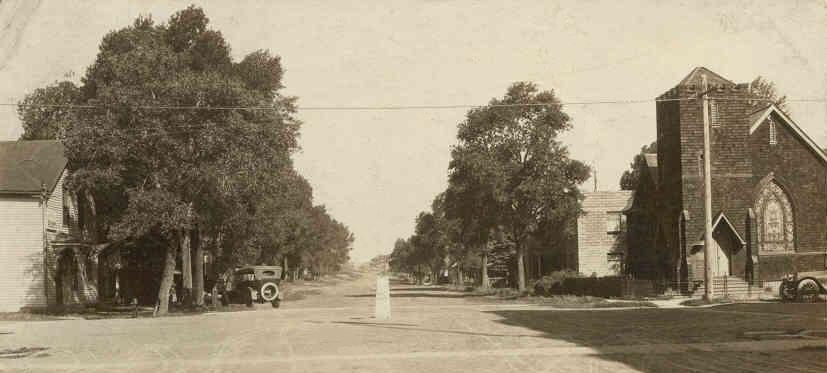
Evanston, Wyoming, approx. 1920
Evanston was founded in November 1868, when the first
graders for the Union Pacific arrived in the area. The first structure, built by Harvey Booth, was a
saloon and restaurant located in a tent on what is now Front Street. Within a month the town
had a population of approximately 650 and was named after James A. Evans, surveyor for the Union Pacific.
The Railroad
reached Evanston in December of 1868. Shortly thereafter Evanston was designated as the county
seat. The Court House was built by Harvey Booth for $15,425. In contrast, in 1907, the Federal
Court House and Post Office was built with the assistance of an apropriation obtained by
U.S. Senator, C.D. Clark from Evanston, in the amount of $184,000.
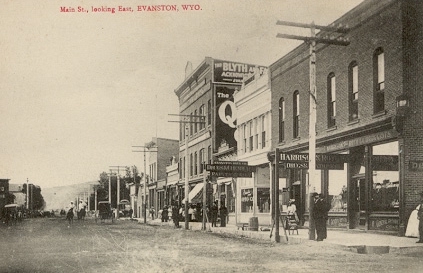 Main Street, approx. 1900, Evanston, looking east.
Main Street, approx. 1900, Evanston, looking east.
Compare this photo with photo from approx. 1918 below right. The first building on right was razed in the 1980's to make room
for a parking lot. At various times it housed different mercantile establishments.
In 1929 is was remodeled as the Phoenix Hall. The three story building at 927 Main Street
is the Blyth and Fargo
merchantile building built by Thomas Blyth and Lyman Fargo in 1872. The third
floor was added in 1887. The building was renovated in 1985 and now houses
professional offices. Blyth and Fargo operated a chain of department stores in
Wyoming, Utah and Idaho, whose motto was "We sell everything but fresh meat and drugs."
The store would even deliver the groceries. In addition to Blyth and Fargo and the
various mercantile establishments, one of the leading clothiers was Isadore Kastor's
store. Kastor opened his business in a meat market in 1885 and moved into his
own building in approximately 1887.
Kastor served as Mayor of Evanston 1913-1915.
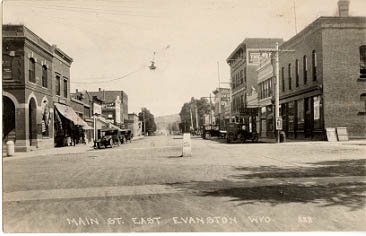 Main Street, Evanston, approx. 1918
Main Street, Evanston, approx. 1918
In this scene taken during World War I, the building on the corner a the time of the
photo housed the
Uinta Mercantile. Leaning against the wall is a sign advertising war bonds.
On the second floor were the offices of the Green River Coal Co., and
a photography studio. Further down the street on the south side, on the right, is a drug store
and a billiard parlor. Across the street from the Blyth and Fargo Building was the dental office of
Dr. B. L. Winslow. The Palace Grocery, 917 Main, on the south side of the street, would
occassionally during "R" months receive fresh Chesapeake oysters by Railway Express.
Dr. Winslow dearly loved the oysters. He was known, when the oysters came in, to
abandon patients in the chair so that he could cross the street to slurp down the delicacies.
On the left is the Evanston National Bank constructed in 1907. On the second floor
were physicians' offices.
The Railroad designated Evanston as a division point, and, thus, unlike many other
tent cities along the line, the future was assured. The town provided the Railroad with ice
for the "reefer cars." Coal was discovered three miles north of town in Almy. Almy, at
one time, was in fact larger than Evanston and had a population at its peak of
approximately 5,000, many of whom were Chinese. The Chinese had originally been
brought in to work on the Railroad and remained to work in the mines.
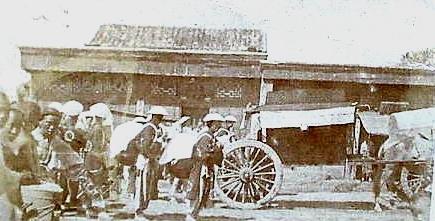 Chinese railroad workers, Rawlins, Wyoming, undated.
Chinese railroad workers, Rawlins, Wyoming, undated.
Indeed, Evanston had one of the
very first Joss Houses [Chinese temples] in the west, constructed in 1874. Each year the
Chinese would celebrate Tet with a parade featuring a Gum Lung, a Chinese
silk dragon, with one individual being designated as the keeper of the
temple for the ensuing year. Many of the Chinese who had to flee Rock Springs in
1885 took refuge in Evanston. See discussion of Rock Springs
Massacre. On January 16, 1922, the Union Pacific
evicted the Chinese from their Company owned houses. Forty-five minutes later
the Joss House burned down. It was known since the Bonneville Expedition that there was
oil in the area. The "oil boom," however, started in 1900 when the Union Pacific drilled
for water and struck oil. At one time there were, as a result, 31 oil companies in the
area. Additionally, the area was able to provide railroad ties to the Railroad. Three companies provided
ties: Evanston Lumber Company, Coe & Carter, and Burns & Bennett.
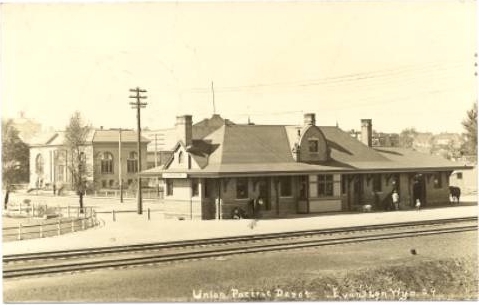 Evanston Depot, 1910
Evanston Depot, 1910 The depot to the right was constructed
in 1901, replacing an earlier depot opened in June 1869. It had two waiting rooms,
one for the ladies with fireplace and one for the men with a potbellied stove.
Behind the depot at the intersection of 10th Street and Front Street
is the Carnegie Library constructed in 1906. The Depot
was donated to the City by the Union Pacific and the plaza in front is used
for community functions. The library building now houses the Chamber of Commerce and
a museum. Other early buildings on Front Street included an Opera House constructed in
1885. With the coming of the Lincon Highway, it was converted into the Transcontinental Garage in 1923.
As indicated with regard to the discussion of
Rawlins, the early highways were a bit rough and not well marked. Harriet
White Fisher in her passage through Evanston in 1909 stopped and asked directions of a
local lawyer, Payson Wilson Spaulding (1876-1972). Fortunately, Spaulding was familiar
with the route since he was the owner of the first motor car in Evanston. In
1906, Spaulding drove from Evanston to Cheyenne and back just to prove it could
be done. As a lawyer, Spaulding remained in active practice into his late 80's, in fact,
taking a case to the Wyoming Supreme Court in 1965 when he was 89 years old.
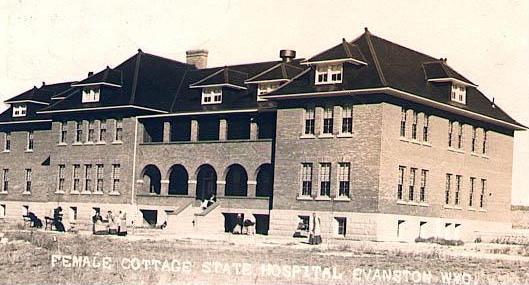
Female Cottage, Wyoming State Hospital, Evanston, undated
Wyoming, from its very beginnings, has had
a concern for the proper treatment of the mentally ill. Its first territorial
legislature passed an act providing for the care of the mentally disturbed in asylums
in the east. The Wyoming State Hospital was completed in 1888.
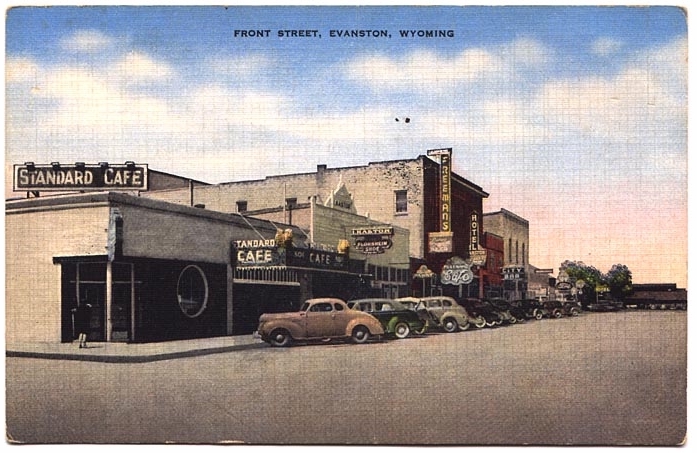
Front Street, Evanston, approx. 1941.
The hotel is the Hotel Evanston constructed in 1912. Between the Standard Cafe and the Hotel, in one story building, is
a bar.
|